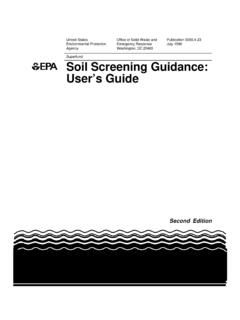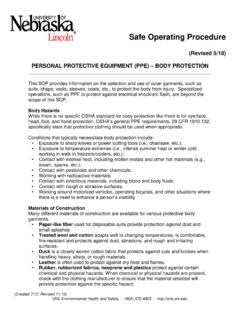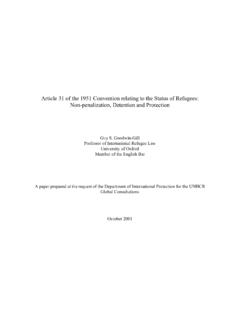Transcription of FACT SHEET: EPA FACTS ABOUT CESIUM-137
1 EPA FACTS AboutCesium-137 EPA FACTS ABOUT CESIUM-137 July 2002 What is CESIUM-137 ? Radioactive CESIUM-137 is produced spontaneously when other radioactive materials such as uranium and plutonium absorb neutrons and undergo fission. CESIUM-137 is therefore a common radionuclide produced when nuclear fission, or splitting, of uranium and plutonium occurs in a reactor or atomic bomb. What are the uses of CESIUM-137 ? CESIUM-137 and its decay product, barium-137m, are used for sterilization activities for food products, including wheat, spices, flour, and potatoes. CESIUM-137 is also used in a wide variety of industrial instruments such as level and thickness gauges and moisture density gauges. CESIUM-137 is also commonly used in hospitals for diagnosis and treatment, as a calibration source, and large sources can be used to sterilize medical equipment.
2 How does cesium change in the environment? CESIUM-137 decays in the environment by emitting beta particles. As noted above, CESIUM-137 decays to a short lived decay product, barium-137m. The latter isotope emits gamma radiation of moderate energy, which further decays to a stable form of barium. CESIUM-137 is significant because of its prevalence, relatively long half life (30 years), and its potential effects on human health. CESIUM-137 emits beta particles as it decays to the barium isotope, Ba-137m (half life = minutes). How are people exposed to CESIUM-137 ? People may be exposed externally to gamma radiation emitted by CESIUM-137 decay products. If very high doses are received, skin burns can result. Gamma photons emitted from the barium decay product, Ba-137m, are a form of ionizing radiation that can pass through the human body , delivering doses to internal tissue and organs.
3 People may also be exposed internally if they swallow or inhale CESIUM-137 . Large amounts of CESIUM-137 were produced during atmospheric nuclear weapons tests conducted in the 1950s and 1960s. As a result of atmospheric testing and radioactive fallout, this cesium was dispersed and deposited world wide. Sources of exposure from CESIUM-137 include fallout from previous nuclear weapons testing, soils and waste materials at radioactively contaminated sites, radioactive waste associated with the operation of nuclear reactors, spent fuel reprocessing plants, and nuclear accidents. CESIUM-137 is also a component of low level radioactive waste at hospitals and research facilities. How does CESIUM-137 get into the body ? CESIUM-137 can enter the body when it is inhaled or ingested. After radioactive cesium is ingested, it is distributed fairly uniformly throughout the body 's soft tissues.
4 Slightly higher concentrations are found in muscle; slightly lower concentrations are found in bone and fat. CESIUM-137 remains in the body for a relatively short time. It is eliminated more rapidly by infants and children than by adults. Is there a medical test to determine exposure to CESIUM-137 ? Generally, levels of cesium in the body are inferred from measurements of urine samples using direct gamma spectrometry (ICRP Publication 54, 1988). Because of the presence of the gamma-emitting barium daughter product, a technique called whole- body counting may also be used; this test relies on detection of gamma photon energy. Skin contamination can be measured directly using a variety of portable instruments. Other techniques that may be used include the taking of blood or fecal samples, then measuring the level of cesium.
5 How can CESIUM-137 affect people s health? Based on experimentation with ionizing radiation and human epidemiology, exposure to radiation from CESIUM-137 can result in malignant tumors and shortening of life. Great Britain's National Radiological Protection Board (NRPB) predicts that there will be up to 1,000 additional cancers over the next 70 years among the population of Western Europe exposed to fallout from the accident at Chernobyl. For scenarios involving nuclear accidents or waste materials the magnitude of the health risk would depend on exposure conditions, such as types of radioactivity encountered, nature of exposure, and time period. What recommendations has the Environmental Protection Agency made to protect human health? Please note that the information in this section is limited to recommendations EPA has made to protect human health from exposure to CESIUM-137 .
6 General recommendations EPA has made to protect human health, which cover all radionuclides including CESIUM-137 , are summarized in the Introduction section of this booklet. EPA, has established a Maximum Contaminant Level (MCL) of 4 millirem per year for beta particle and photon radioactivity from man-made radionuclides in drinking water. CESIUM-137 would be covered under this MCL. The average concentration of CESIUM-137 which is assumed to yield 4 millirem per year is 200 picocuries per liter (pCi/l). If other radionuclides which emit beta particles and photon radioactivity are present in addition to cesuim-137, the sum of the annual dose from all the radionuclides shall not exceed 4 millirem/year. For more information ABOUT how EPA addresses CESIUM-137 at Superfund sites, please contact either: EPA s Superfund Hotline 1-800-424-9346 or 1-800-535-0202 or EPA s Superfund Radiation Webpage















